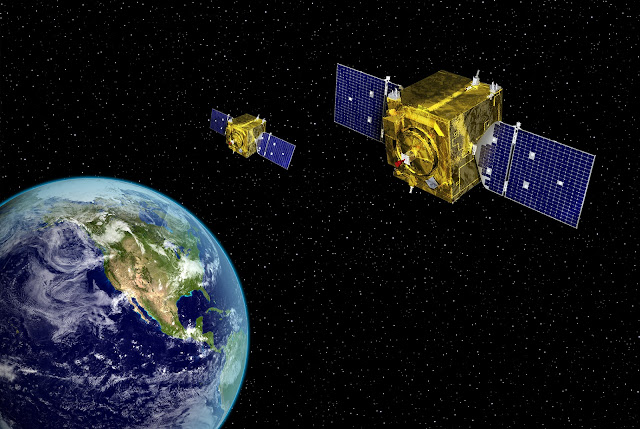 |
| Credit: U.S. Air Force illustration |
By Andrew Bennett
What Is Potential Energy?
Potential energy (sometimes called "stored energy") is the energy associated with the positions of objects. These objects also exert forces on one another, and they tend to move toward certain arrangements.
What Is Gravity?
Gravity is an attractive force (attractive = pulls together rather than pushes apart) that exists between any pair of objects. The amount of gravity depends on the mass of each object and the distance between them. Since the force between "small" objects like you and me is so small, we usually only bother with pairs of objects that include a planet, moon, star, black hole, or some other large celestial object.
Gravitational Potential Energy Definition
Gravitational potential energy (GPE) is the energy of objects attracting each other via a gravitational force. Although all objects do this, we will most commonly care about the interaction of large objects (such as planets, moons, or stars) with other objects (large or small).
Gravitational Potential Energy Formulas
The most common gravitational potential energy example is the energy of objects that are some distance from the Earth, usually slightly above the Earth's surface. As such, we have two formulas. The first is a general formula for calculating the GPE between two objects. The objects can be large or small, near to each other or far apart. The second is a shortcut formula for objects near Earth's surface.
General GPE Equation
The following equation is used to calculate the gravitational potential energy of two objects, based on their masses and their arrangement:
In this equation, Ug is the gravitational potential energy. G is the gravitational constant, which has a value of:
In this equation, Ug is the gravitational potential energy. G is the gravitational constant, which has a value of:
m1 and m2 are the masses of the two objects in the pair being examined. Finally, r is the distance between the centers of the two objects.
This form of the equation works every time, but as you can see, it's a bit of a pain. Since most of the problems we will work in a physics class are situations on Earth, near the surface, we have a shorter and easier version of the equation that already has those assumptions made and plugged in.
Shortcut GPE Equations
More often than not, what we care about is actually how much the GPE has changed from one moment to another, not what the value is at some particular instant. In fact, we just decide where we want the objects to be when we say there is zero GPE in the system. In the equation above, there is zero GPE when the two objects are infinitely far apart. In this next equation, we'll have some choice about where that zero point should be.
When we are dealing with the Earth and some object near the Earth's surface, we can use the following formula:
When we are dealing with the Earth and some object near the Earth's surface, we can use the following formula:
In this formula, Ug is the gravitational potential energy, m is the mass of the small object (not the Earth), g is the acceleration due to gravity at the Earth's surface (9.8 m/s2), and h is the height of the object above or below a zero that you establish. Typically, we would set zero at ground level, but there is no requirement for this. It is sometimes easier to set a different zero. For example, if a child is on a swing and we are calculating their speed at the bottom of the swing, it may be more useful to set the zero height to the position of the child at the bottom of their swing, rather than at the ground.
Sometimes (such as on the AP exam) this will be written as:
This format reminds us that what we are finding is the difference in potential energy between this arrangement and what it would be if the smaller object were at the defined "zero point." Other than that, the equation is used exactly the same way as described above.
It is worth noting that you will NOT get the same answer for gravitational potential energy using the general equation and the shortcut equation because the zero points are defined differently. If you calculate the difference in GPE between two arrangements, though, both equations will give you the same difference.
Finally, you can use this shortcut equation for objects near the surface of the moon, Mars, or any other celestial object. All you need to change is the value for g. Near Earth's surface, g = 9.8 m/s2, but this value will differ elsewhere. For example, on the moon, g = 1.6 m/s2.
GPE Video Explanation
This AP physics video lesson explains the meaning of gravitational potential energy and the two equations for calculating it. It also has an example problem and solution with each formula.
Subscribe for More Physics Video Tutorials
Please subscribe to my YouTube channel for videos about gravity, energy, forces, work, and other physics topics.




Comments
Post a Comment